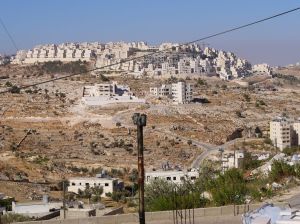This is the Har Homa settlement, a suburb of Jerusalem built during the 1990's. It is the perfect example of an attempt to imitate the complex form of the traditional hill town without employing any of the same processes. As a result the repetition of shapes at the scale of buildings gives away the production process as a type II physical phenomenon and not a complex living environment. Who could truly love it?
To quote James Howard Kunstler, in a region where his words have a much more urgent significance, will this be a place worth defending?

Comments
Great post. It's funny to see developers try to imitate organic settlements yet fail so miserably. Suburban residential developments in North America try to do the same thing, really - curvilinear streetstrying to imatate organic growth, as if housing has naturally grown up along some old and winding farm road.
Design through the manufactured process can't imitate the design of natural process. It is the process which must form the deisgn, not the other way around, I think.
really glad to see this post, Mathieu! i've been fascinated by this issue recently... of 'how they build in Palestine.' both b/c of current events in the region (i.e. Gaza) and b/c of a book i think you and your blog followers would be interested in:
"Hollow Land: Israel's Architecture of Occupation", by Eyal Weizmann.
peace :)
mohamad
Hi Mathieu,
as someone doing the AAS course at the Bartlett - a program which, effectively, is about unpacking Bill Hillier's theories - I must say that following your blog (something I have only just started doing very recently) is such a pleasure: well done! A question: Are you aware of any studies done on processes of emergence and randomness restriction for informal settlements/shantytowns?
All the best,
Fred
Hello Matheiu,
I agree with you that this is not emergent urbanism, but in reality there was no attempt here to copy the complex form of a traditional hill town. The form is a result of applying the various regulations of planning and building, tranportation and parking on an extremely difficult topography. It would probably not have been constructed at all, and certainly not at such high density, if not for strategic - tactical reasons of establishing Jewish presence on the land.
I am saying this from first hand knowledge, as I worked for the Minsitry of Housing and supervised some of the planning of this area.
Yodan